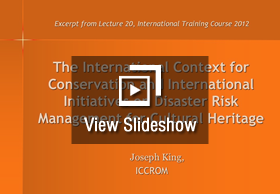

This section outlines the need for an integrated approach for disaster risk management of cultural heritage by identifying the links between disaster risk management, sustainable development and heritage conservation and management.
A lecture should discuss the developments in the fields of disaster risk management of cultural heritage, internationally as well as relating to participants’ local and regional contexts through secondary examples. If needed, the instructor may connect this lecture to local, regional and national policies on cultural heritage and disaster risk management. This subject may also be undertaken at a later stage in the course.
The International Context for Conservation and International Initiatives on Disaster Risk Management for Cultural Heritage, International Training Course 2012
Instructor: Joseph King
Duration: 60 minutes

Based on the length and focus areas of the course, thematic content emphasising management systems specific to the region, local policies and planning approaches could be introduced at this stage. A running primary case study, which would include site visits and workshops through various modules of the course, can also potentially be introduced here in order to connect back to it through each stage of the course.
A visit to a local heritage site may be arranged at this juncture of the module. The various site management policies, local policies and national and international frameworks that apply to it could be clearly illustrated to participants by the site manager or any other assigned resource persons with extensive knowledge of the site as well as the applicable policies. The history and background of the site and region may also be presented as part of these sessions or as a separate session, as a presentation or part of the site visit.
This section outlines the need for an integrated approach for disaster risk management of cultural heritage by identifying the links between disaster risk management, sustainable development and heritage conservation and management.
The following organisations and policy documents could be introduced:
The following issues need to be highlighted:
Core Lectures
A lecture should discuss the developments in the fields of disaster risk management of cultural heritage, internationally as well as relating to participants’ local and regional contexts through secondary examples. If needed, the instructor may connect this lecture to local, regional and national policies on cultural heritage and disaster risk management. This subject may also be undertaken at a later stage in the course.
Thematic Lectures
Based on the length and focus areas of the course, thematic content emphasising management systems specific to the region, local policies and planning approaches could be introduced at this stage. A running primary case study, which would include site visits and workshops through various modules of the course, can also potentially be introduced here in order to connect back to it through each stage of the course.
A visit to a local heritage site may be arranged at this juncture of the module. The various site management policies, local policies and national and international frameworks that apply to it could be clearly illustrated to participants by the site manager or any other assigned resource persons with extensive knowledge of the site as well as the applicable policies. The history and background of the site and region may also be presented as part of these sessions or as a separate session, as a presentation or part of the site visit.
The International Context for Conservation and International Initiatives on Disaster Risk Management for Cultural Heritage, International Training Course 2012
Instructor: Joseph King
Duration: 60 minutes
The instructor introduced the international context for the various initiatives that have been undertaken for disaster risk management for cultural heritage at a global level. He introduced the structure and evolution of international organisations such as the UNESCO World Heritage Centre, ICOMOS, and ICCROM. The scope of other international organisations such as ALESCO, SPAFA, European Union / Council of Europe, private bodies such as the Getty Conservation Institute, World Monuments Fund were also discussed. These were then linked to the international organisations dealing with issues of disaster risk management such as UNISDR, Global Platform and Regional Platforms, World Bank, NGO’s and Civil Society. Bilateral and Multilateral Development Agencies such as the World Bank, Sida, and USAID were also briefly discussed.
The specific mandate of ICCROM and its commitment to promoting the conservation of cultural heritage worldwide was briefly discussed.
Finally a strategy for risk reduction for World Heritage Properties was discussed by the instructor. This lecture related to other discussions initiated within this module and the previous modules dealing with international agencies concerned with the disaster risk reduction and disaster risk management of cultural heritage at a global scale.
Potentially, this type of lecture could be placed in an earlier module (Module 1) or towards the end of a course (Module 6)